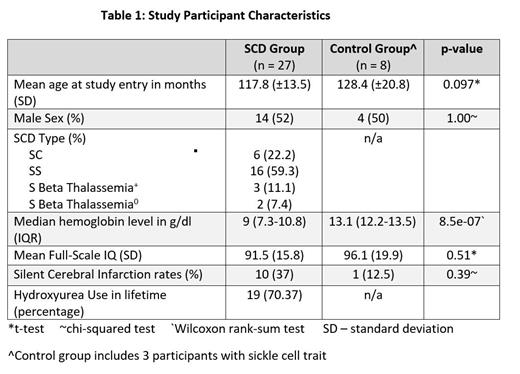Introduction:
Sickle cell disease (SCD) is a genetic blood disorder affecting multiple organ systems, particularly the brain (Pinto, V.M. et al 2019). Neurocognitive deficits can occur in the presence or absence of overt brain injury, such as stroke or silent cerebral infarction (SCI). Using diffusion tensor imaging (DTI) metrics, multiple studies have identified widespread white matter alterations in individuals with SCD. DTI abnormalities, such as decreased fractional anisotropy (FA) and increased mean diffusivity (MD), have been associated with decreased processing speed in this population (Stotesbury et al. 2018). The goals of this study are to 1) define developmental differences in diffuse (brain-wide) white matter microstructure between SCD and control pediatric participants and 2) determine medical and neurocognitive characteristics of pediatric participants with SCD and abnormal DTI metrics.
Methods:
Thirty-eight participants between 8 to 12 years of age with no prior known history of stroke, SCI, or seizures were recruited for a prospective longitudinal study. Study groups consisted of 28 participants with SCD and 10 sibling or unrelated control participants. This study was a cross-sectional analysis of participants who completed DTI scans and neuropsychological testing at study entry (n=35).
DTI was obtained on a 3T Philips research scanner 2.2mm nominal isotropic resolution; 32 diffusion directions obtained at b=700 s/mm 2. Preprocessing, tensor estimation, and calculation of FA and MD maps were performed using DTI Studio/MRICloud and its pediatric DTI atlas.
Neurocognitive evaluation was performed and interpreted by a trained psychology associate with supervision from a board-certified neuropsychologist and included intelligence testing (Weschler Intelligence Scale for Children, WISC-5).
Statistical analyses were performed using STATA 18 and MATLAB 2022a. We examined cohort-level demographics using chi-square tests, T-tests, and Wilcoxon rank sum tests (Table 1). To examine diffuse differences in white matter microstructure development, we used 19 bilateral white matter regions of interest [ROIs] shown in prior research to be important in patients with SCD with and without SCI. We examined MD and FA values within ANOVA models (each in terms of Group*Age + ROI) to assess group-level differences (SCD vs. control) and group x age interactions.
We used ANOVA loadings to compute global MD and FA scores and computed 95% prediction intervals by age based on control participants. We identified participants with SCD with global scores suggestive of white matter microstructural differences (high MD and/or low FA) and compared their overall neurocognitive profiles.
Results:
The SCD and control participants were similar with regards to age, sex, and full-scale IQ. SCD participants had significantly lower median hemoglobin levels than control participants. There was one control participant who met criteria for SCI.
SCD vs. control group status, age, and group x age interactions all significantly impacted our MD model (explaining 0.8%, 1.1%, and 0.8% of total variance, respectively; all p<0.001). MD decreased with age in the combined cohort (β=-9.3±1.6e-7/month) with significant flattening of this trend in children with SCD (group x age interaction: β=+7.9±2.0e-7/month). In contrast, only age significantly impacted our FA model (p<0.001, explaining 1.1% of variance); group status and group x age interactions each explained <0.2% of variance in FA.
Four children with SCD had global DTI metrics suggestive of white matter injury (one with high MD and low FA; two with high MD only; one with low FA only). All 4 participants with abnormal DTI metrics had abnormal MRIs, three of whom had SCI and one of whom had lesions that did not meet the size criteria for SCI. Three participants had full scale IQs 1 standard deviation below the expected mean of 100 (<85).
Conclusion:
We identified differences in global white matter microstructural indices between SCD and control participants with an apparent blunting of expected decreases in mean diffusivity with age. Our continuing longitudinal study will explicitly assess DTI trajectories and implications for neurocognitive functioning in children with SCD.
Disclosures
Casella:Immunarray Ltd and Johns Hopkins UniversityHopkins University Hopkins University: Patents & Royalties: James F. Casella is entitled to royalties on a license for a brain biomarker panel. This arrangement has been reviewed and approved by the Johns Hopkins University in accordance with its conflict of interest policies. ; None: Patents & Royalties: James F. Casella holds a patent for aptamers that are potential treatments for sickle cell disease..


This feature is available to Subscribers Only
Sign In or Create an Account Close Modal